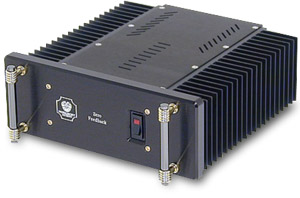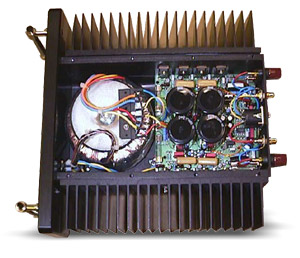![[SoundStage!]](../titles/sslogo3.gif) Home
Audio Home
Audio Equipment Review |
|||||||||||||||||||
February 2001 Monarchy Audio SM-70 Pro Amplifierby Wes Phillips
When Marc Mickelson assigned me the Monarchy SM-70 Pro for review, I wasn't sure what to expect. I knew Monarchy made well-respected digital gear, such as the DIP, but other than that I drew a blank. Within days I received two compact boxes that broke the mold for high-end audio amplifiers -- I was able to tote both boxes up the staircase in a single trip, unassisted. Upon opening the shipping boxes, I discovered that I had received, not a pair of monoblocks, but two toy-like stereo amplifiers. Small, yes, but also perfectly formed. With their thick faceplates and robust binding posts, these sure weren't wimpy-looking amps. And, as I discovered upon reading the tersely worded owner's manual, they weren't necessarily the 25W stereo rigs they seemed at first, but honest-to-gosh completely balanced monoblocks -- at least when their XLR inputs were employed. As the great David Bromberg put it, "Don't let the glasses fool ya'/ Stand beside me when you measure my size…." Don't let false estimations rule you… The $980 USD SM-70 Pro looks like an elegant toy -- something simultaneously precious and butch, like a Tonka Toy bulldozer. It's only 5" tall by 11" wide by 12" deep, but its black anodized aluminum metalwork and cumbrous transformer cause it to weigh in at 24 pounds. Each amp has a pair of Art-Deco-ish handles on the front -- they're marbleized cylinders supported by heavy, gold-plated wires that wrap around the handles three times. It's a pretty effect, but don't be fooled -- the handles are there to be used and give you sufficient leverage to hoist and haul the amplifier around. The SM-70 Pro is designed as a 25Wpc stereo amplifier that can also be bridged to perform as an 80W monoblock. What the amp is really designed for, however, is to be used as a fully balanced mono amplifier -- when its XLR input is used, it routes the positive and negative legs of the signal to the left and right channels of the amplifier. The loudspeaker is then connected to the positive binding posts for each channel (right being positive and left being negative). The SM-70 also has a switch that will bridge the amplifier when a single-ended input is used; the amp then routes the output of the left channel's gain-stage op-amp (a Burr-Brown OPA2604) through a resistor into the inverted input of the op-amp's right channel. Thus the right channel's voltage gain is controlled by the left's op-amp. Monarchy describes the SM-70 Pro as a "zero-feedback" design, although the op-amp gain stage does actually employ a standard non-inverting feedback loop. However, the MOSFET output stage is an open-loop design with no global feedback returning to the input -- so, in that sense, their description is correct. The amplifier's power supply consists of a hefty 480VA toroidal transformer with 60,000pF storage capacitors.
A note to audiophiles who are hung up on "name" passive components: Get over it! Sometimes the expensive big-name passive components don't necessarily sound better than the plain vanilla variety. I know several high-end manufacturers who conduct blind evaluations of passive parts within their circuits, and they don't always find a sonic advantage to the pricier resistors and circuit boards. Sometimes, yes, they do; but don't sneer at a product just because it doesn't use audiophile-approved components. I stand tall with the unseen powers… I figured I'd try a single SM-70 Pro first, so I connected it to the C-J Premier 17LS using the RCA inputs, driving Dynaudio Contour 1.3 Mk. IIs. I was startled by how sweetly detailed it sounded driving those current-hungry monitors. I listened to Sam Bush's Late As Usual [Rounder 1040-2] and just marveled at how clean and clear his fabulous mandolin playing sounded. "Sailin' Shoes" -- yes, that "Sailin' Shoes" -- was full of piss'n'vinegar, spitting out chord after chord, rivaling any Little Feat live performance of the tune I've ever heard with its boisterous energy. Late is an impeccable studio recording, and the SM-70s allowed me to hear reasonably far into the soundstage, but not all the way in. I was conscious of it sounding too clean -- notes seemed to die without decaying fully.
Nor was I able to really engage the Dynaudios with a single SM-70. Larger ensembles, such as Duke Ellington's band, just didn't have the slam and impact I have come to expect from them, as I discovered when I played The Great Paris Concert [Atlantic 304-2]. The solo piano "Kinda Dukish," which started Ellington's live sets, came across great, complete with the pianist's grunts and moans, but when Ellington modulated down into the opening bars of "Rockin' In Rhythm," where the band enters blowing full bore…well, the sound just didn't have the power and the majesty that I know that passage ought to have. Sometimes 25Wpc just won't cut it. So I switched both SM-70s into bridged mode and listened that way. Power may corrupt, but it can also wrest a lot more music out of certain loudspeakers. And that's exactly what it did with the Dynaudios. The bridged SM-70 Pros caught a lot more detail than the unit did as a stereo amplifier -- and had the dynamic reserves that 25W just didn't command, as well. The overall sound was still warmish, but not overly so. The Sam Bush album regained its sense of spaciousness -- or at least I was now hearing the size of the room it was recorded in. Soundstaging was solid and the stage ran deep, back to my front wall, if not much beyond it. And timbres rang true as could be; I was hearing small differences between instruments I wasn't able to capture with the amp running stereo. I rule the spirits that live in the wild wood… But I just couldn't escape the feeling that I wasn't getting it all. There was a slightly coarse quality to transients and details that was preventing the transitions from silence to sound from being as sharp as I have become used to with my reference Nu-Vista 300. So I reckoned it was time to run the SM-70 Pros in their balanced mode. Naturally, this was one of those ideas that sounded simpler than it proved to be, since the Premier 17Ls had only SE outputs. So first I substituted the Ayre K1x, feeding the Monarchy from one of its pairs of RCA outputs; only after I had grown used to the difference the change in preamps made did I switch to its balanced XLR outputs. Wow! The difference isn't subtle. I'd have to say that the SM-70 Pro is a balanced-input monoblock amplifier that ranks with the really great ones -- and, if necessary, it can be used as a stereo or bridged SE amp, at considerable cost to its performance. Running fully balanced, the SM-70 Pros exhibit a level of transparency that is simply awe-inspiring -- especially in comparison to other operational modes. Their clarity and punch are amazing. Take the Ellington disc, for instance. In fully balanced mode, the SM-70 Pros really let Ellington's piano style shine through -- the dynamic ebb and flow are much more in evidence than they were in my previous auditions, and I could clearly distinguish the left and right handfuls of chords as he strode towards the band's cue. And Oh! My! Goodness! what an entrance when the entire ensemble came in on the Dun da da dun DUN opener of "Rockin' In Rhythm." And so it continued in listening session after listening session. I'd forget about making comparisons, caught up in this or that musical revelation. But throughout, I marveled at the sweet, detailed, dynamic, overwhelmingly natural sound of the system. What superb little amps. I tried them out on the Thiel CS7.2s, partially because they can be a brutal test for an amplifier, but also because the disparity in size amused me. Believe it or not, they can drive the Thiels, but they're not the first amp you'd choose for the task. They'd play to a certain loudness level and then plateau, refusing to go further. It wasn't so much a case of the SM-70s sounding bad, they just reached a point where they refused to go further. That's fine -- nobody in their proper senses would construct a system where an 80W amplifier drove the 7.2s anyway. I also listened to the active subwoofer/passive mid/high Polk RT 3000P with the SM-70 Pro, both as a stereo amplifier and as a fully balanced monoblock. No question about it, the Polks were a beautiful match for the Monarchys. As a stereo amp, the SM-70 added a touch of sweetness to the midrange/tweeter module that made for some of the best sound I'd heard from the speakers. But once again, good as that was, balanced operation was far, far better and astonishingly more dynamic. If the Monarchy SM-70 Pros have taught me one unexpected lesson, it is that the swing from silence to a full-blown crescendo is far greater than we normally settle for, even in ambitious systems -- and that's something the SM-70s re-create in their balanced configuration better than any number of ordinary amplifiers. And every evening I talk to stars I thoroughly enjoyed auditioning the Monarchy SM-70 Pro amplifier. It seemed extremely well made and well thought out. At nearly a thousand bucks, I'm not sure it represents fantastic value as a stereo amplifier, however. That kind of money buys you any number of stereo amplifiers with twice the power. But, having said that, there are two points I'd like to make. One is that the amplifier can be found for far less than its suggested list price, making it more of a bargain. The second is that I don't really see it as a stereo amp at all -- to hear what it can do, you have to have a fully balanced source or preamplifier and you need a pair of the SM-70 Pros. Then you'd be in a position to hear what they do best. And, when you consider that fully balanced monoblocks from the big boys cost over $5000 per channel, the entry fee for a pair of Monarchys seems like a relative bargain. All I can say is that it's going to be hard to give these amps up when the time comes to ship them back to San Francisco. Give them a chance to charm you, and you might have a hard time turning them down. ...Wes Phillips
|
|||||||||||||||||||
|
|||||||||||||||||||
![[SoundStage!]](../titles/sslogo3.gif) All
Contents All
ContentsCopyright © 2001 SoundStage! All Rights Reserved |

 All told, the SM-70 Pro is smartly built -- it's solid as
a brick and tightly put together. The black anodized aluminum chassis is bolted firmly to
3/8"-thick extruded aluminum heatsinks. The front panel is a chunky 3/4" thick,
and its appointments include Teflon-insulated gold-plated RCA inputs, a substantial XLR
input, and hefty, gold-plated five-way binding posts with plastic lugs. Parts quality
throughout is solid, if not profligate: Monarchy employs metal-film resistors, a
combination of silver-mica (small value) and polypropylene (large value) capacitors, and
circuit boards that are substantial but certainly not exotic.
All told, the SM-70 Pro is smartly built -- it's solid as
a brick and tightly put together. The black anodized aluminum chassis is bolted firmly to
3/8"-thick extruded aluminum heatsinks. The front panel is a chunky 3/4" thick,
and its appointments include Teflon-insulated gold-plated RCA inputs, a substantial XLR
input, and hefty, gold-plated five-way binding posts with plastic lugs. Parts quality
throughout is solid, if not profligate: Monarchy employs metal-film resistors, a
combination of silver-mica (small value) and polypropylene (large value) capacitors, and
circuit boards that are substantial but certainly not exotic.